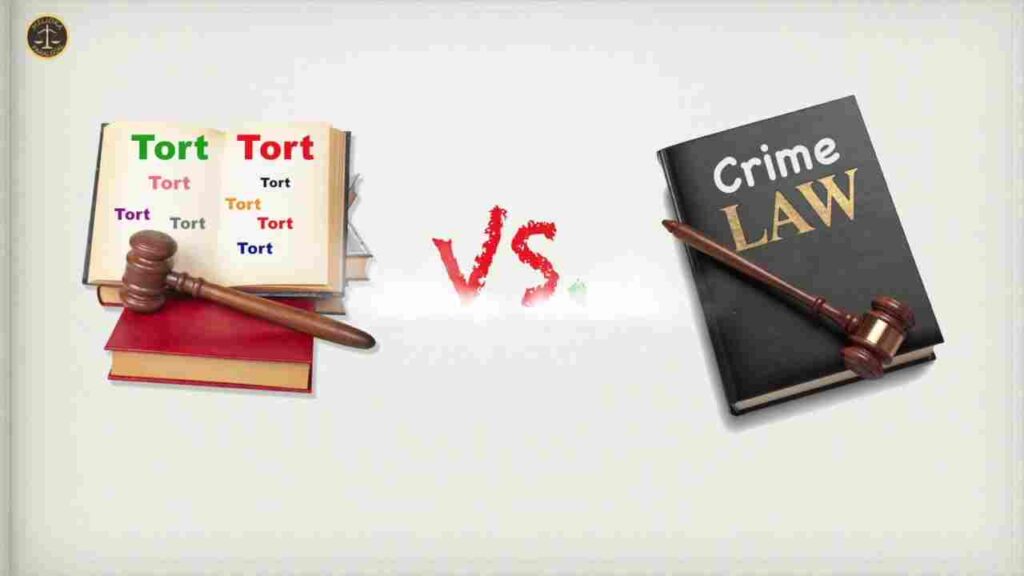
Write down 15 Key Difference between Tort and Crime
Differentiating between torts and crimes is crucial in the realm of law. Although both torts and crimes involve wrongful acts, they possess significant dissimilarities. Here in this article we are going to discuss about 15 key Difference between Tort and Crime that set torts and crimes apart.
Difference between Tort and Crime
Nature of Wrongful Act: A tort refers to a civil wrongdoing committed against an individual or their property, whereas a crime entails a violation of a criminal statute punishable by the state.
Parties Involved: In a tort, the involved parties are typically the injured party (plaintiff) and the alleged wrongdoer (defendant). In a crime, the parties consist of the state or government as the prosecutor and the accused as the defendant.
Burden of Proof: In a tort case, the burden of proof lies with the plaintiff, who must demonstrate that the defendant’s actions caused harm. In a criminal case, the prosecution bears the burden of proof, having to prove the defendant’s guilt beyond a reasonable doubt.
Intent: Torts may encompass both intentional and unintentional actions, whereas crimes typically require intent or a guilty state of mind known as mens rea.
Punishment: Torts are resolved through compensatory remedies, such as monetary damages, aimed at restoring the injured party to their original state. Crimes, however, may result in punishment, including fines, imprisonment, probation, or community service.
Public Interest: Crimes are considered offenses against society as a whole, and prosecuting them serves the public interest. Torts, on the other hand, focus on individual rights and interests.
Proceedings: Tort cases are initiated by filing a civil lawsuit, while criminal cases commence through formal criminal charges.
Standard of Proof: In tort cases, the standard of proof is usually a preponderance of the evidence, meaning it is more likely than not that the defendant’s actions caused harm. In criminal cases, the standard is higher, necessitating proof beyond a reasonable doubt.
Jury Trials: Tort cases can be decided by a judge or a jury, depending on the jurisdiction and the parties’ preferences. Criminal cases generally involve a jury trial, except for minor offenses.
Statute of Limitations: Torts have specific time limits within which a lawsuit must be filed, which vary by jurisdiction and the nature of the claim. Crimes may also have statutes of limitations, but they are generally longer than those for torts and depend on the severity of the offense.
Constitutional Protections: Criminal defendants enjoy constitutional protections, such as the right to an attorney, the right to remain silent, and the presumption of innocence until proven guilty. These protections do not apply to tort cases.
Civil Liability: Tortfeasors may be held liable for damages, including compensatory and punitive forms. Criminal defendants, if found guilty, face criminal penalties rather than direct compensation to the victim.
Social Consequences: While tortious acts primarily have private consequences, criminal acts can have broader social implications, impacting public safety and the general welfare of society.
Role of Government: The government plays a central role in prosecuting crimes, being responsible for enforcing criminal laws and maintaining public order. In torts, the government’s involvement is limited to providing a legal framework and resolving disputes between private parties.
Double Jeopardy: The principle of double jeopardy safeguards individuals from being tried twice for the same offense in criminal cases. This protection does not apply to torts, enabling plaintiffs to seek compensation through both civil and criminal proceedings.
By recognizing these 15 difference between tort and crimes, legal practitioners and individuals can navigate the complex terrain of civil and criminal law with greater clarity and understanding.
Also Read: Explore 15 Key Difference between Respiration and Combustion